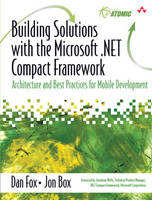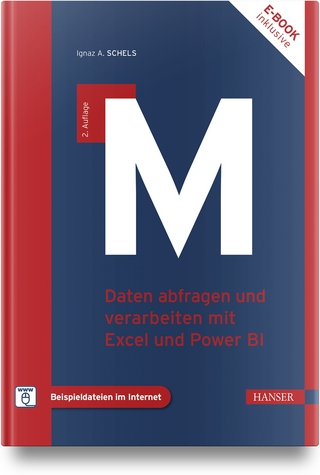
Building Solutions with the Microsoft .NET Compact Framework
Addison-Wesley Educational Publishers Inc (Verlag)
978-0-321-19788-7 (ISBN)
- Titel ist leider vergriffen;
keine Neuauflage - Artikel merken
The .NET Compact Framework (CF) is a version of the .NET Framework for mobile devices such as cell phones, PDAs, and Pocket PCs. The final versions of the CF and the Smart Device Extensions (SDE) were released in February of 2003, yet in spite of widespread interest in the technology, there has been very little information released so far to help developers master these powerful new tools. Together the CF and the SDE provide a rich development environment for building both stand-alone and connected applications on both the Pocket PC and Windows CE platforms. The authors have been teaching developers about the CF and SDE for months now, and have based this book on the real-world questions raised - and solutions developed - in those training sessions. The authors strike a perfect balance between the "whys" of mobile development, the architecture, and the "hows", the best practices. Busy developers will appreciate their concise style.
0321197887AB07242003
Foreword.
Preface.
Acknowledgments.
About the Authors.
I. THE PDA DEVELOPMENT LANDSCAPE WITH THE COMPACT FRAMEWORK.
1. The Rise of Mobile Devices.
Executive Summary.
The Need for Mobility.
Information Anywhere, Anytime, and on Any Device.
Using Information.
Anywhere and Anytime.
On Any Device.
Microsoft and Mobility.
Operating Systems.
Platforms.
Development Tools.
The Compact Framework and SDP in Context.
The Role of the ASP.NET Mobile Controls.
What's Ahead.
Related Reading.
2. Components of Mobile Development.
Executive Summary.
.NET and Smart Devices.
XML Web Services.
Windows .NET Framework.
Goals of the Compact Framework and SDP.
The .NET Compact Framework.
Architecture.
Portability.
SDP.
Project System.
.NET Language Support.
UI Support.
Emulators.
Debugging.
Additional Tools.
What's Ahead.
Related Reading.
II. ESSENTIAL ARCHITECTURAL CONCEPTS.
3. Accessing Local Data.
Executive Summary.
The Need for Local Data Handling.
Using File I/O.
Reading and Writing Text Files.
Asynchronous File Access.
Manipulating Files and Directories.
Handling XML.
Using the DOM.
Using XML Readers and Writers.
Using XML Writers.
Working with Relational Data.
ADO.NET in the Compact Framework.
Reading and Writing Data.
Displaying Data.
Data Binding.
Manual Binding.
What's Ahead.
Related Reading.
4. Accessing Remote Data.
Executive Summary.
Have PDA, Will Travel.
Wireless Application Factors around Accessing Remote Data.
Application Factors.
Connection Type and Distance.
Throughput.
Battery Power.
Communication Hardware for the Mobile Device.
Cost.
How the Compact Framework Addresses Accessing Remote Data.
XML Web Services.
Accessing SQL Server Remotely.
Using Pluggable Protocols.
Direct Communication with Sockets.
Communicating with TCP and UDP.
Communicating Using Infrared.
Other Issues in Network Communications.
Compact Framework Asynchronous Capabilities in Networking.
What's Ahead.
Related Reading.
5. Caching Data with SQL Server CE.
Executive Summary.
The Role of SQLCE.
History of SQLCE.
Robust Data Caching.
SQLCE Architecture.
SQL Server CE Engine.
Query Analyzer.
Accessing SQLCE.
SqlServerCe Provider Architecture.
Manipulating Data with SqlServerCe.
Administering SQLCE.
Security.
Database Maintenance.
Installation and Deployment.
What's Ahead.
Related Reading.
6. Primitive Synchronization.
Executive Summary.
The Importance of Synchronization.
What ActiveSync Is.
Backup and Restore.
Software Install.
Mobile Explorer.
File Conversion.
Remote Communication.
Connection Notification.
The ActiveSync Architecture.
ActiveSync Service Manager.
ActiveSync Providers.
Creating a Partnership.
Developing ActiveSync Applications.
A Managed Application Using File Synchronization.
Utilizing RAPI in a Managed Application.
Considerations for a Pass-Through Application.
What's Ahead.
Related Reading.
7. Data Synchronization.
Executive Summary.
SQLCE Synchronization.
Connectivity Architecture.
Connectivity Features.
RDA.
Features and Scenarios.
Configuration.
Using RDA.
Merge Replication.
Features and Scenarios.
Configuration.
Using Replication.
What's Ahead.
Related Reading.
III. ADDITIONAL PROGRAMMING CONSIDERATIONS.
8. Localization.
Executive Summary.
The Need for Globalization and Localization.
Guidelines for Globalization and Localization.
Globalization and Localization Support.
Understanding Cultures.
Localizing Data.
Using Resources and Satellite Assemblies.
Other Localization Issues.
Localized Exception Strings.
Testing World-Ready Applications.
What's Ahead.
Related Reading.
9. Securing Compact Framework Solutions.
Executive Summary.
Security Issues and Principles.
Securing the Device.
Authentication.
Antivirus Protection.
Lockdown.
Securing the Application.
Authentication.
Data Protection.
Securing User Input.
Securing Communications.
Secure Sockets Layer.
Virtual Private Networks.
Wired Equivalent Privacy.
Custom SOAP Extensions.
What's Ahead.
Related Reading.
10. Packaging and Deployment.
Executive Summary.
Packaging and Deploying in the Compact Framework.
Versioning in the Compact Framework.
Private Assemblies.
Shared Assemblies.
Packaging Compact Framework Applications.
Setting Project and File Options.
Creating a CAB File.
Deployment and Installation.
Using ActiveSync.
Using a Web Site.
Using a Storage Card.
Using a File Share.
Setting Up Autodeployment.
What's Ahead.
Related Reading.
11. Developer Challenges.
Executive Summary.
Issues and Challenges.
Augmenting the Compact Framework.
Using PInvoke.
Additional Tools.
Measuring and Improving Performance.
Measuring Performance.
Enabling Performance Statistics.
Performance Issues.
Improving Performance.
A Final Word.
Related Reading.
Index.
| Erscheint lt. Verlag | 6.11.2003 |
|---|---|
| Verlagsort | New Jersey |
| Sprache | englisch |
| Maße | 177 x 234 mm |
| Gewicht | 580 g |
| Themenwelt | Informatik ► Betriebssysteme / Server ► Windows |
| Mathematik / Informatik ► Informatik ► Netzwerke | |
| ISBN-10 | 0-321-19788-7 / 0321197887 |
| ISBN-13 | 978-0-321-19788-7 / 9780321197887 |
| Zustand | Neuware |
| Haben Sie eine Frage zum Produkt? |
aus dem Bereich


